A sketchbook filled with smart templates makes every blank page less scary and way more exciting. Imagine doodle playgrounds, messy mind maps, or a travel diary loaded with ticket stubs and wild stories. There’s even room for illustrated quotes, crazy character makeovers, and artsy collage grids to keep things fresh. Organizational tools—like challenge trackers and planning charts—cut chaos and help big ideas shine. If you want even more ways to keep your creativity explosive, just wait for what’s next!
Key Takeaways
- Doodle exploration pages encourage playful creativity by filling sketchbook spreads with spontaneous drawings, colorful accents, and experimental lettering.
- Creative mind map layouts visually organize brainstorms around a central theme, using branches, colors, and mixed media for inspiration and idea clarity.
- Project planning matrices break big creative ideas into actionable steps, helping track progress and maintain focus during complex art projects.
- Character development frameworks offer structured templates for building unique characters, including spaces for sketches, backstories, and style exploration.
- Texture study sections guide artists to experiment with cross-hatching, stippling, and real-life item sketching, sharpening observational skills and artwork depth.
Doodle Exploration Page
Sometimes, all a sketchbook needs is a little wild energy, and that’s where the Doodle Exploration Page comes in. This isn’t just any old sketchbook page—think of it as a playground for your creative process.
Artists get to fill the whole space with random doodles, drawing anything from zany characters to slices of pizza, and even the weird lamp on their desk. Geometric shapes, organic swirls, wild lines—there are no rules! Doodling kicks perfection out the window and invites in pure fun, sparking all sorts of new ideas.
Using different colors or funky writing makes your artistic journey even wilder. Plus, the more Doodle Exploration Pages you make, the more your personal style grows—and so does your confidence!
Creative Mind Map Layout
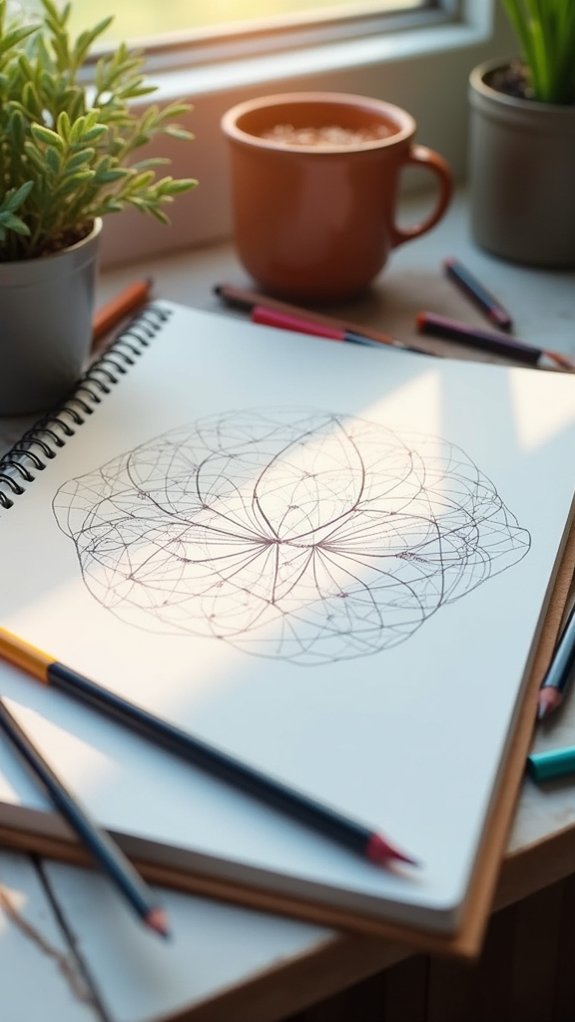
A creative mind map layout is like a superhero for your ideas, helping you actually see how everything connects around one main topic.
Using branches, colors, and doodles, it turns brainstorming into a wild adventure, sparking new thoughts you never saw coming.
With mind maps, who knew problem-solving could feel like building your own secret lair for ideas?
Visualizing Concept Connections
When creative ideas start bouncing around like popcorn in a microwave, a mind map can help capture them before they explode out of control.
With Sketchbook Ideas, a creative mind map layout brings order to the chaos, letting artists actually see how concepts connect. Branches shoot out in every direction like brainstorm spaghetti, showing links between thoughts that might not be obvious at first.
Using wild colors, bold shapes, and squiggly lines for different categories makes the whole thing pop—literally! Images and funky symbols help ideas stick in your brain longer than plain old text ever could.
As artists revisit their mind maps, tweaking and adding new thoughts, they’re tracking their creative journey. It’s like having a treasure map for cool ideas, with no wrong turns.
Enhancing Idea Generation
Bursting with energy, creative mind map layouts are like rocket fuel for big ideas, blasting past boring lists and releasing a tidal wave of brainstorming power.
These mind maps organize thoughts visually, making it easier to spot those wild connections you’d totally miss with a simple list. By branching out—literally—ideas can sprout in every direction, which means surprises and new perspectives are always around the corner.
Throw in mixed media—think doodles, colors, stickers, you name it—and you’ve got a memory-boosting, creativity-sparking masterpiece right in your sketchbook. Fast to make and ridiculously easy to update, mind maps are the dream tool for quick thinkers.
- Branches and sub-branches expand brainstorming possibilities
- Mixed media elements keep things colorful and memorable
- Images, symbols, and doodles boost creative thinking
- Frequent revising turns rough ideas into polished gems
Travel Diary Spread
Travel diary spreads are like a backstage pass to your own adventures, letting you sketch out favorite spots, cool buildings, or even that guy with the wild hat on the street.
Plastering in ticket stubs, doodles, or funny quotes from the trip makes each page feel totally personal, kind of like a scrapbook and journal mashed together.
Visualizing Memorable Destinations
Even after the suitcases are unpacked and the souvenirs find a shelf, memories of amazing trips tend to linger in the mind like bright flashes. A visual diary is the perfect way to grab those memories before they fade, turning them into colorful sketches and notes.
Sketching the rolling hills of Tuscany or weird birds spotted in Costa Rica feels like magic. The spread jumps to life when organized so every glance turns into a trip down memory lane.
Here’s how to bring those destinations to the page:
- Sketch vistas, unique buildings, or local wildlife for a real sense of place
- Write short notes or funny travel stories alongside the pictures
- Mix in photographs, sketches, and maps for variety
- Play with watercolors, pencils, or pens for a creative twist
Incorporating Personal Travel Mementos
Souvenirs don’t always have to be shiny things from the gift shop—sometimes the best treasures are scraps picked up along the way.
When you fill your sketchbook, tossing in ticket stubs, postcards, or tiny pieces of maps turns your travel diary into a time machine. Imagine flipping open a page and remembering that wild bus ride or the ice cream you tried in a new city—just from a ticket glued to the corner!
Try mixing collages with sketches of local buildings or weird plants you saw. Scribble a note about your favorite snack, or that funny thing someone said.
Using different layouts, like grids or messy piles, each spread feels like an adventure scrapbook, making your memories feel even more real.
Expressive Journaling With Sketches
An expressive journal spread is like a party for your memories—every ticket stub, sketch, and silly note is invited.
When someone creates a travel diary page in their sketchbook, they can mix different artistic styles for extra fun and energy. There’s no right or wrong way—just whatever feels right in the moment.
By combining fast doodles of markets, busy streets, or new friends with colorful reflections, the memories start to feel alive long after the trip ends. Throw in a boarding pass or some wild local wrapper, and suddenly, the story jumps off the page.
Here are some ideas for a lively travel diary spread:
- Layer sketches, notes, and mementos from each stop
- Mix in various artistic styles
- Add ticket stubs or tiny postcards
- Use a colorful background scheme
Collage Composition Grid
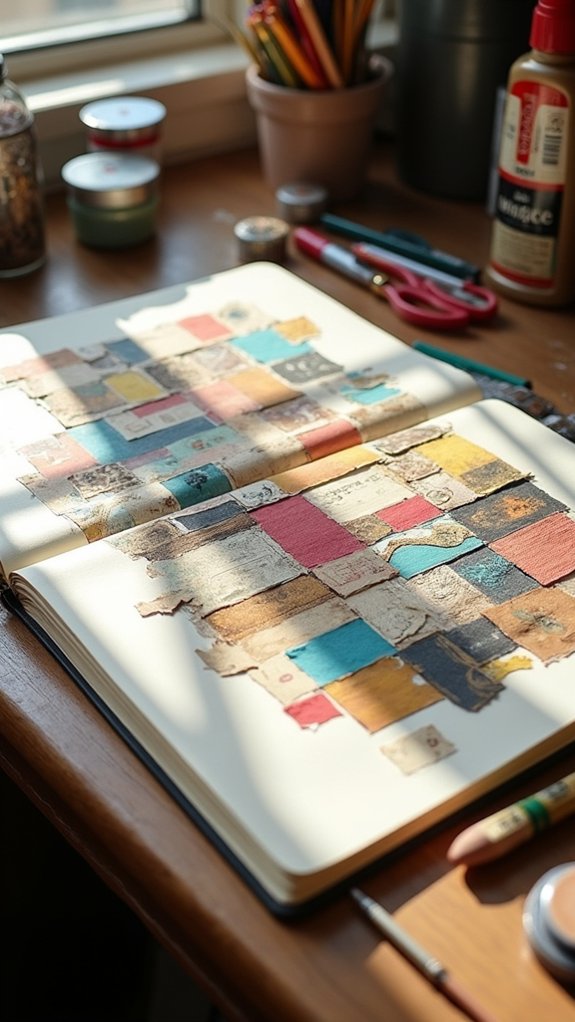
Sometimes, the creative chaos of collage making can feel a bit wild, but that’s where a collage composition grid swoops in to save the day. Imagine a page sliced up into neat little boxes—suddenly those ideas swirling in your head have a place to land. It’s like giving every picture, sticker, or scrap its own home, so nothing gets lost in the shuffle. Grids come in all shapes, but a simple 3×3 or 4×4 grid is usually enough to keep things organized without making it boring. This layout makes it way easier to move pieces around and tell a story with your art. Check out this table for quick collage composition grid inspiration:
| Grid Configuration | Creative Purpose |
|---|---|
| 3×3 | Balanced storytelling |
| 4×4 | Complex arrangements |
| Horizontal rows | Thematic grouping |
| Vertical columns | Narrative progression |
| Mixed cells | Dynamic compositions |
Illustrated Quote Box
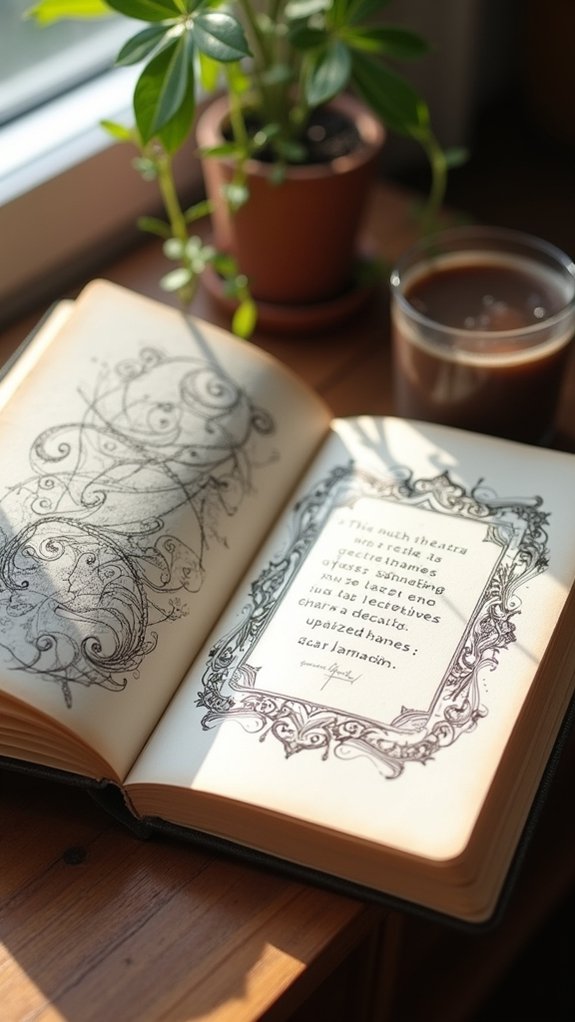
An illustrated quote box is where creative lettering meets storytelling, and wow, can it make a sketchbook page pop!
Using different typography techniques, like bold swirls or comic book bubbles, lets artists show off each word’s personality, while clever drawings add extra punch to the message.
It’s so much more than just words on a page—it’s like your favorite quote taking center stage in its own mini scene.
Creative Typography Techniques
Even though it might seem like just picking a cool font is enough, there’s a whole world of creative typography techniques waiting to make an illustrated quote box pop off the page.
Seriously, typography is more than pretty letters—it’s about making each word stand out and helping the quote’s message shine. From tall, bold words that feel confident to swirly, hand-drawn letters that look playful, anyone can mix things up.
Want some quick tips? Try these:
- Play with font styles, weights, and sizes to make important words jump out.
- Add hand-lettering or doodles for a personal, one-of-a-kind touch.
- Use contrasting colors or textured fills in the letters for extra drama.
- Combine text with subtle decorative elements for a unified, awesome look.
Typography = instant creativity boost!
Visual Storytelling With Quotes
Usually, a quote feels more powerful when it leaps off the page, dressed up with colors, drawings, and cool lettering. That’s what visual storytelling with quotes is all about—taking an artistic phrase and making it POP with imagination! By mixing creative lettering and sketchy doodles, anyone can turn their favorite saying into a mini masterpiece. Whether you use watercolor splashes, inky borders, or collage backgrounds, the illustrated quote box lets you play with theme and mood. Adding your own reflections or a funny twist doesn’t just decorate the page—it makes your art personal and relatable. Choosing the right layout guides the reader’s eye, so your words shine. Here’s a table to get those artistic feelings flowing:
| Feeling | Color | Motif |
|---|---|---|
| Hope | Yellow | Rising sun |
| Joy | Pink | Balloons |
| Bravery | Purple | Mountain |
Storyboard Panel Arrangement
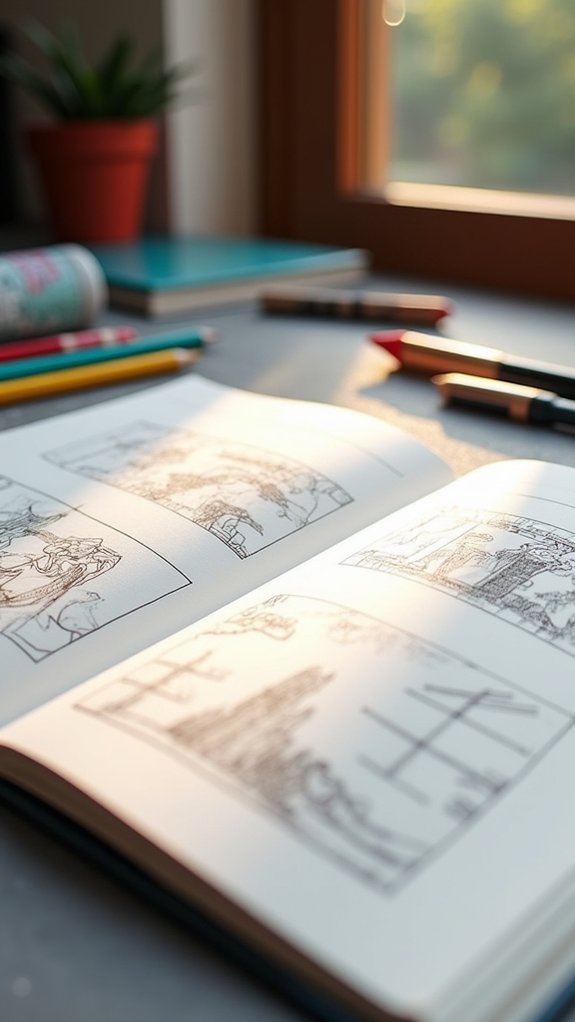
Storyboard panels might look simple at first—just boxes in a grid—but there’s a lot more going on beneath the surface!
Think of each little box as a window into the next big moment of your story. Some artists even create mind maps before sketching so their ideas jump onto the page in the perfect order.
Getting your storyboard arrangement right makes your comic, short film, or animation way easier to follow. It’s like building a roller coaster—every turn needs to be in just the right place!
To keep things fresh and fun, try mixing up layouts or packing in arrows and notes to show action.
Here’s what to focus on:
- Clear sequences with numbered panels
- Varying panel sizes for dramatic moments
- Space for dialogue, notes, and doodles
- Annotations for movement and mood
Mixed Media Experimentation Sheet
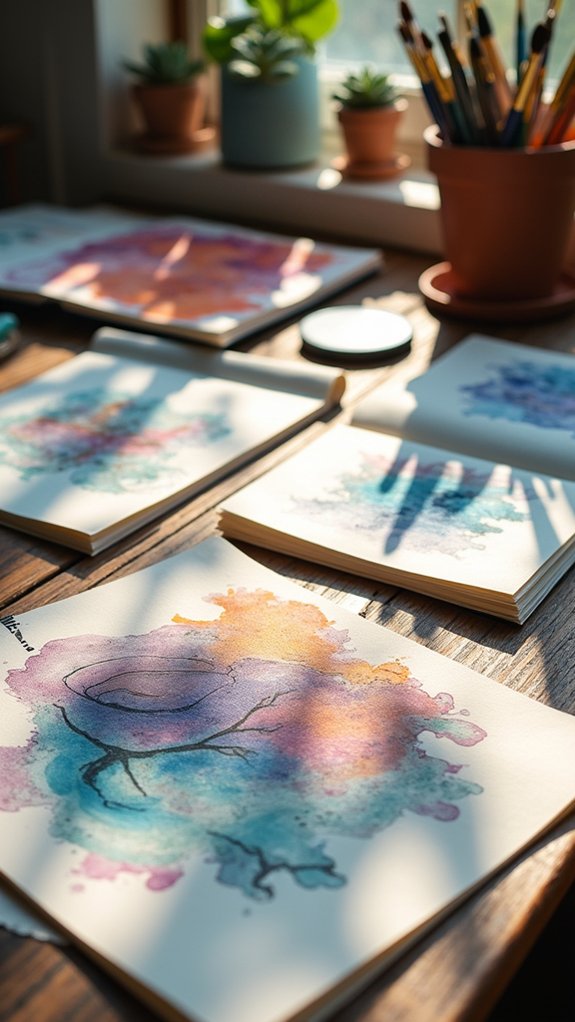
A mixed media experimentation sheet is where things get wild—think layering blobs of paint over magazine clippings, or scratching ink right on top of dried glue.
Artists get to push boundaries by trying out layering tricks and tossing together weird, unexpected materials, like foil, thread, or even popcorn (movie night art, anyone?).
This kind of page makes trying new combos fun, and even if it gets a little messy, that’s all part of the adventure.
Layering Techniques Exploration
When it comes to mixed media art, layering is where things really start to get exciting—like, “Whoa, how did you even do that?” exciting.
Imagine stacking new colors, textures, and patterns until your page looks like it’s bursting with secrets. Layering techniques let artists mix paints, inks, and collage elements to form wild combinations that grab people’s attention.
It’s kind of like making art lasagna, and each layer brings its own flavor. A well-designed sketchbook template for this kind of experimentation might include spaces for artists to jot down what they tried, what surprised them, and ideas for the next round.
- Try glazing with transparent paints over bold backgrounds.
- Stack paper scraps or fabrics to test tactile effects.
- Combine inks and watercolors, then layer pen details.
- Record what’s new and awesome after each layering experiment.
Combining Unconventional Materials
Even though most people might stick to paper and pencil, real magic kicks in once artists start mixing in stuff that totally doesn’t belong—like thread, dried leaves, or torn bits of newspaper straight from last week’s comics section.
When creating a mixed media experimentation sheet, artists can glue fabric scraps, string, buttons, or actual pieces of nature right onto their sketchbook pages. Mixing these oddball materials makes artwork pop with weird and awesome textures, and, honestly, it’s way more fun.
Make sure to try different adhesives: maybe a glue stick works for paper, but double-sided tape handles tricky fabric flamboyantly.
Try watercolors splashed over crinkly newsprint or sprinkle ink across textured cloth. Each experiment adds depth and stories, turning ordinary art into something you want to keep flipping back to.
Daily Gratitude Block
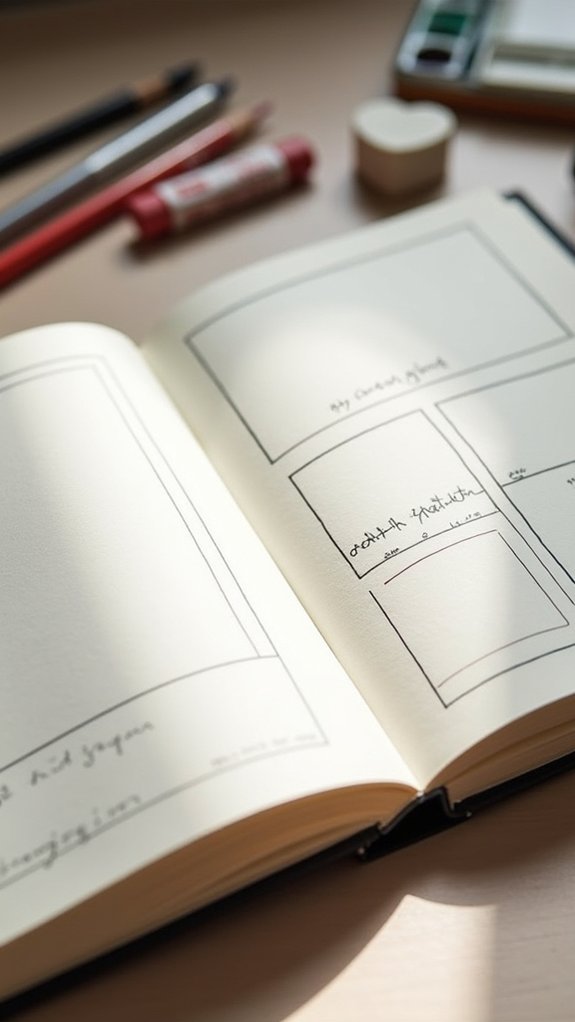
Gratitude has a surprising superpower—it can totally flip someone’s mood before they even finish breakfast. That’s why adding a Daily Gratitude Block to a sketchbook is more than just another creative prompt; it can actually enhance your observational skills.
By doodling, scribbling, or jotting down what’s good—even if that’s just “found the last cookie”—people nudge their minds into noticing the small victories. It’s like training your brain to spot sparkles in a gray day.
Plus, these blocks become colorful visual journals over time, capturing growth and resilience in the margins. And hey, a sketch of your happy cat counts!
- Jot down three things you’re grateful for today
- Illustrate a moment that made you smile
- Use colors that match your mood
- Add doodles to highlight special memories
Pattern Design Framework
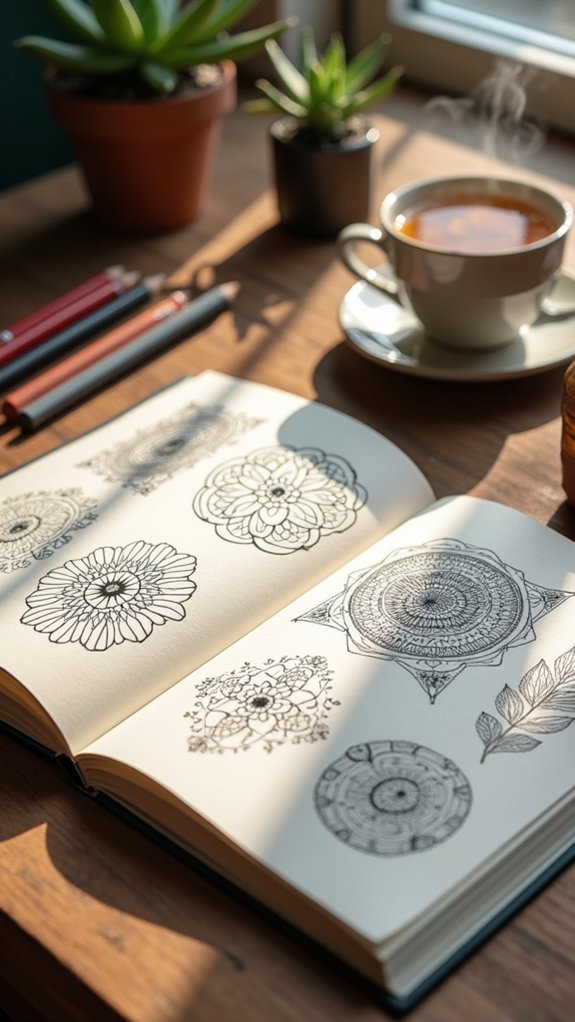
Although it might seem like patterns are just repeating shapes over and over, there’s actually a whole secret world hidden in a single page of loops, zigzags, and squiggles. Diving into a pattern design framework is like opening a doorway to endless creativity—where someone can try something really wild or stick to neat, tidy lines. Sketchbook patterns aren’t only about making things look cool; they also help artists build focus, patience, and their own style. Mixing up markers, watercolor, or collage keeps it exciting. Every page is a chance to experiment or challenge yourself with new ideas. Check out this handy table for five playful ways to structure your next pattern page—go ahead, try something totally unexpected!
| Technique | Challenge |
|---|---|
| Use only circles | Mix three colors |
| Try wavy lines | Collage bits |
| Mirror patterns | Add texture |
| Tiny motifs | Layer designs |
| Spiral repeats | Swap tools |
Character Development Template

While patterns can fill a page with wild shapes and surprising color combos, sometimes all the magic comes from a character brought to life in the margins. A character development template makes this magic possible, giving creators a place to jot down everything about their new imaginary friend.
There’s more to it than just a funky name or a cool hairdo—this tool digs deep, with spots for background stories and wild personality quirks. Want to see their journey from shy sidekick to bold hero? The template has you covered.
It even helps spark drama by mapping out friendships and rivalries.
- Name, age, background, and traits for quick reference
- Sketch space for doodles and style notes
- Arcs charting the character’s evolution
- Relationship maps for conflict and connection
Visual Diary Timeline
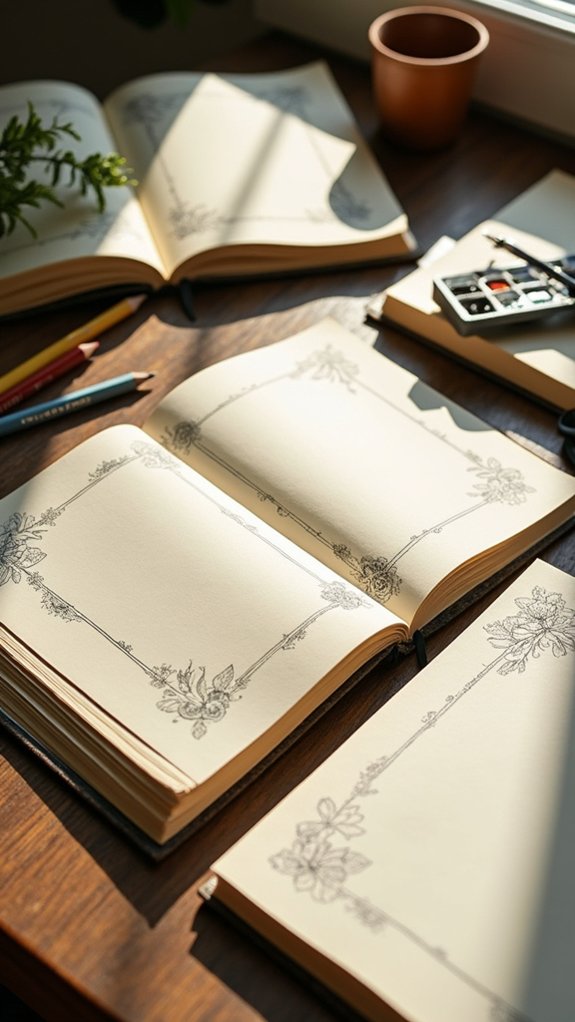
Sometimes, a regular diary just can’t capture all the wild ups and downs of daily life—so why not sketch it out instead? Enter the visual diary timeline, a fantastic way for artists to record each crazy day with pictures, words, and a splash of creativity. For someone starting this for the first time, it may feel like telling your life story one colorful page at a time! By adding dates and notes beside each doodle or watercolor scene, artists can look back and actually see how much they’ve changed. Using the same color scheme or page layout ties it all together while giving each entry its own style.
| Entry Date | Highlights & Feelings |
|---|---|
| Jan 3 | First time sketching outdoors—so cold! |
| Jan 10 | Tried collage; felt super creative |
| Jan 15 | Watercolor experiment—happy accident! |
| Jan 21 | Drew my pet, laughed at silly nose |
Artistic Challenge Tracker
After flipping through days filled with colorful diary sketches, it’s only natural to start itching for something new—like a creative mission or two.
Enter the artistic challenge tracker, a super-powered tool for shaking up your sketchbook routine and making every page count. This tracker is basically a map for curious artists, guiding them to discover new ways to draw, paint, or doodle.
- Mix up techniques: dabble in pencil, watercolor, or digital just for fun
- Set bold goals: tackle a “30 faces in 30 days” challenge or invent wacky creatures
- Track your journey: mark off finished prompts and admire your improving skills
- Give yourself prizes: small treats after knocking out big challenges make it even sweeter
With an artistic challenge tracker, there’s always something fresh to try!
Texture Study Section
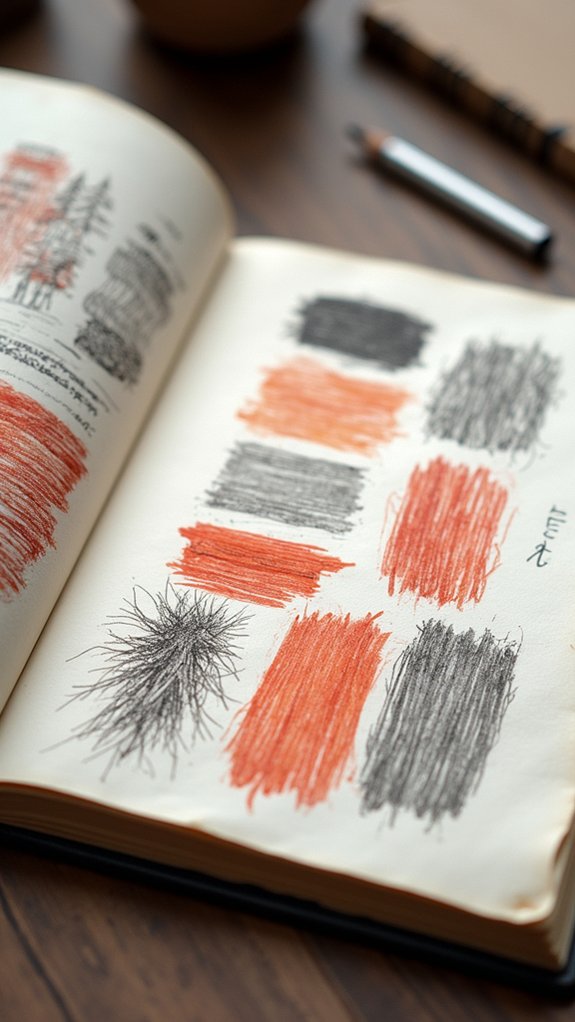
Imagine running your fingers across a fluffy sweater, a bumpy pinecone, or even the shiny surface of a dinner plate—textures are everywhere, and they’re bananas fun to draw.
The Texture Study Section in a sketchbook is all about capturing the look and feel of different textures. Artists experiment with techniques like cross-hatching, scribbling, or stippling to make paper roar with the illusion of roughness, smoothness, and everything in between.
Sketching from real-life items—think leaves, denim, or even dog fur—helps you notice tiny details, like how shadows make things pop. Practicing with different textures sharpens observation skills and boosts creativity.
Plus, it’s a ticket to giving sketches real oomph and depth. Why settle for flat art when you can add life?
Dream and Vision Board Outline
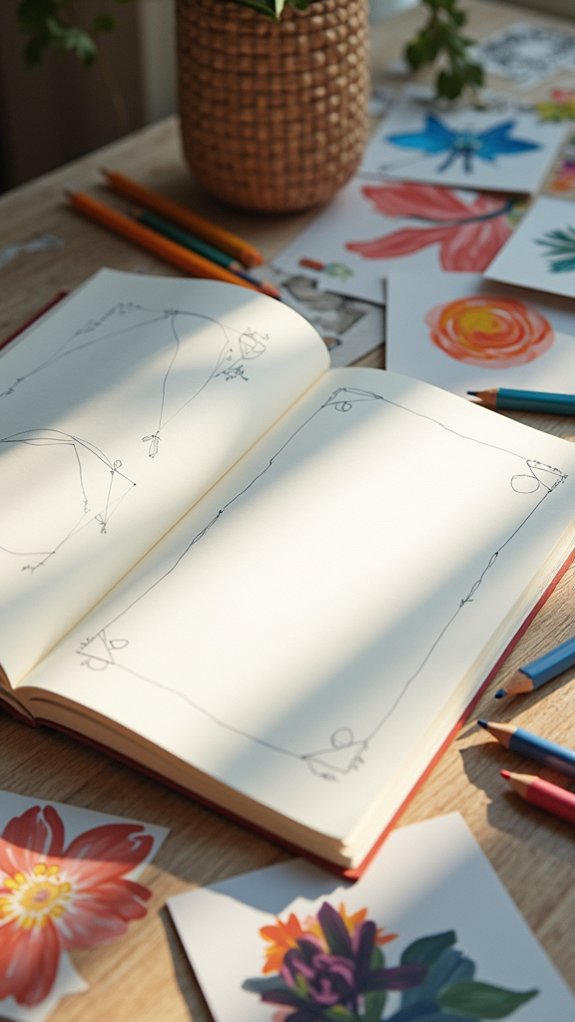
When life feels like a giant question mark, a dream and vision board can be the ultimate way to pin down some answers, or at least give your biggest hopes a place to hang out.
A solid dream and vision board outline is all about taking those wildest dreams and breaking them into pieces you can actually see on paper. That might look like magazine cutouts, old photos, inspiring quotes, or even doodles that make you smile.
Some people add fabric swatches for extra texture or symbols that just mean something special. The best part? You’re free to update it as your goals grow and change, so it never gets stale.
- Mix up images, quotes, and drawings
- Add personal symbols
- Play with different textures
- Keep revisiting and updating
Transformation Sequence Page
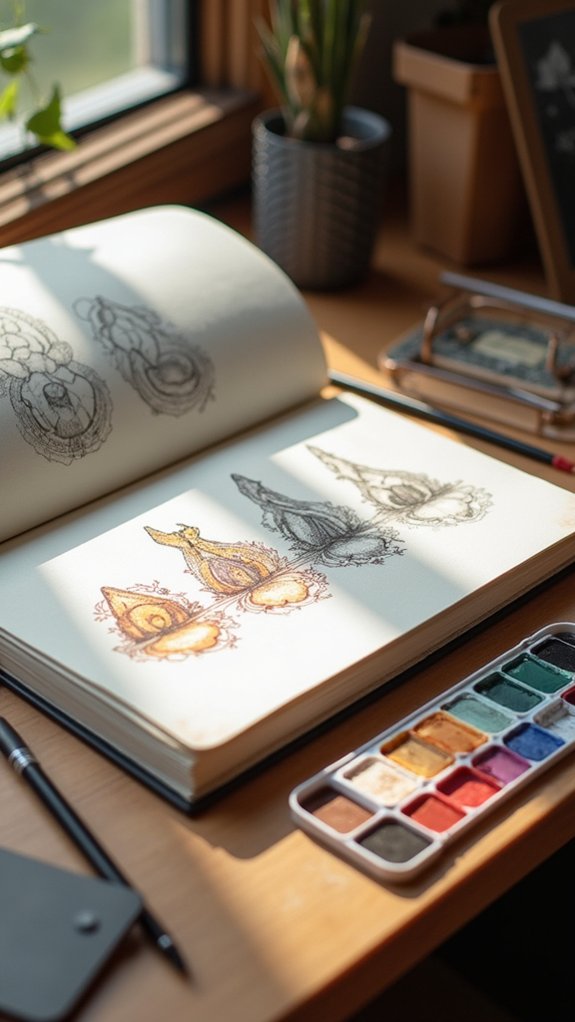
Transformation—it’s like magic on a sketchbook page. The transformation sequence page lets artists show how things morph, grow, or even turn totally weird, all in a neat row of drawings.
Imagine a frog turning into a prince, or a plain sandwich becoming a burger with all the works! Each stage is labeled, so you can clearly see every wild change, and sometimes there are quick notes explaining what’s happening.
Different pencils, crazy colors, or cool painting styles turn each stage into something special. This template isn’t just about cool art; it’s about really thinking, “What comes next?”
Artists get to be curious experimenters, learning not only how things change, but also why. Who knew sketches could be so dramatic—and funny?
Project Planning Matrix
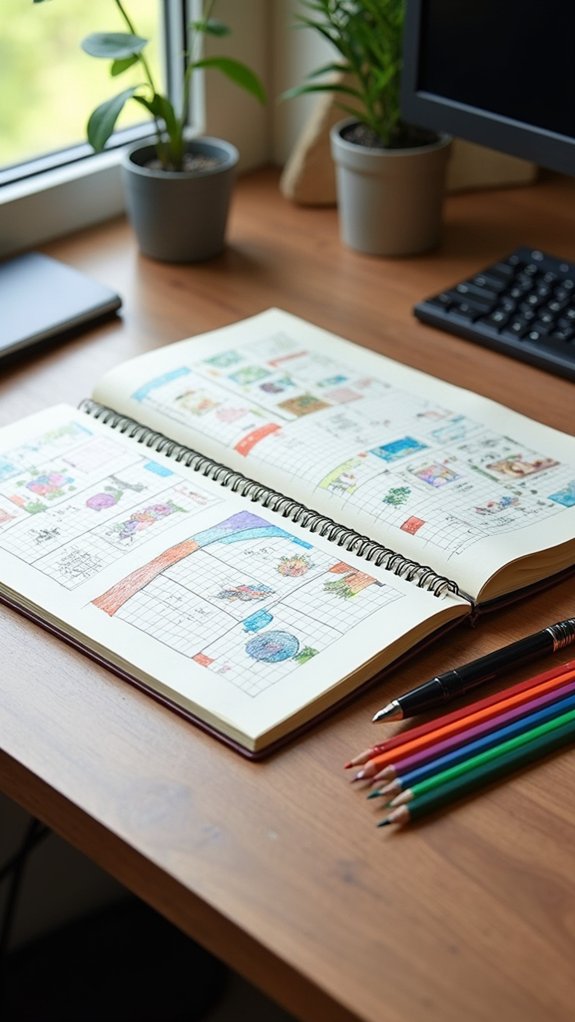
Lots of artists know the struggle—juggling a dozen creative ideas at once, only to end up with a ball of confusion instead of a masterpiece.
Enter the project planning matrix: like a superhero sidekick for creativity, it helps tame those wild projects with the power of organization. It’s not some boring chart, either. This tool turns chaos into order by breaking ideas into clear pieces, and is especially helpful when projects are big, messy, or need teamwork.
With columns for goals, deadlines, supplies, and who’s in charge, the project planning matrix keeps everyone on the same page—literally.
Here’s why it’s a game-changer:
- Organizes creative chaos into steps
- Tracks progress for every stage
- Makes sharing the work crystal clear
- Helps quick-brainstorming without overwhelm
Reflection and Growth Area
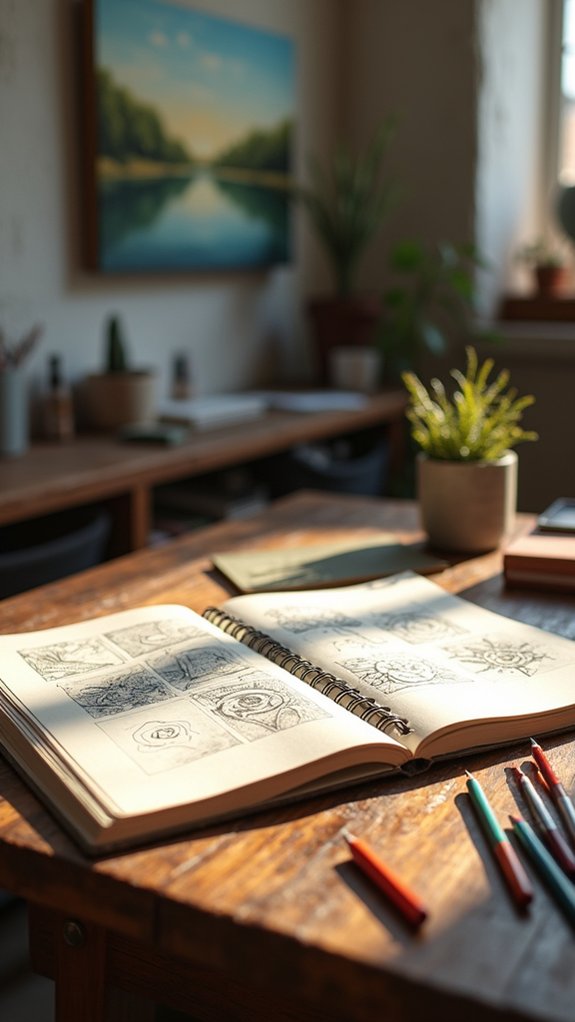
Some sketchbooks are just a place to doodle, but the real magic happens in the reflection and growth area. This is where artists dig deeper, using special spaces in their sketchbook to analyze their progress—sort of like a detective investigating their own art journey.
Prompts for self-reflection help artists figure out what works, what flopped, and what emotions popped up along the way. Flipping back to old sketches? Huge confidence boost! Spotting how much you’ve improved is almost as inspiring as your favorite playlist.
The reflection and growth area isn’t just serious business, though. Celebrate small wins: nailed that tricky perspective, experimented with new colors, survived a day without smudging everything. This space cheers artists on, keeping creativity flowing and goals in sight.
Frequently Asked Questions
What to Put in a GCSE Art Sketchbook?
A GCSE art sketchbook should contain observational drawings, experiments with art techniques and mixed media, studies of relevant artists, annotated reflections, documented idea progression, mind maps, photographs of artworks, research, and initial sketches, showcasing creativity and development.
What to Draw 100 Ideas?
When seeking what to draw, individuals can explore 100 Creative Prompts spanning nature, emotions, objects, characters, and abstract concepts. Incorporating daily challenges and seasonal themes guarantees diverse inspiration, while experimenting with mediums broadens artistic skillsets and engagement.
How Do You Make a Good Sketchbook Spread?
To make a good sketchbook spread, one should prioritize visual harmony by integrating balanced visuals and text, experimenting with varied layouts, techniques, and color schemes, and including insightful annotations to create cohesive, engaging compositions that document the creative process.
How to Make Your Sketchbook Interactive?
Making a sketchbook interactive involves incorporating interactive elements such as fold-out pages, pockets for loose materials, collaborative sections, mixed media textures, and QR codes. These engage users by inviting touch, contribution, and discovery, enriching the overall creative experience.
Conclusion
With these 17 sketchbook templates, anyone can shake off creative blocks faster than a cat chasing a laser pointer. Whether someone wants to doodle, plan projects, or map wild dreams, there’s a layout here that’ll spark new ideas. Sometimes, just seeing a blank page is intimidating, but with these fun and clever templates, every page becomes an adventure. So grab that sketchbook—it’s time to draw, doodle, and maybe even surprise yourself with what you create!

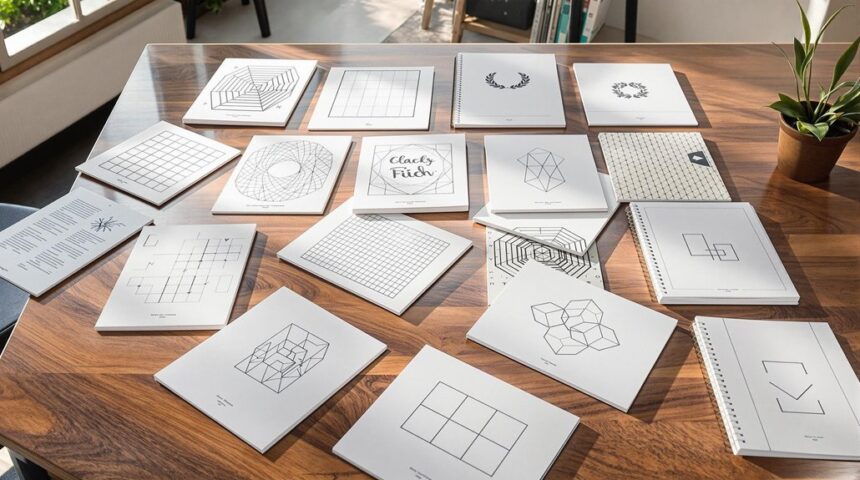
Leave a Reply